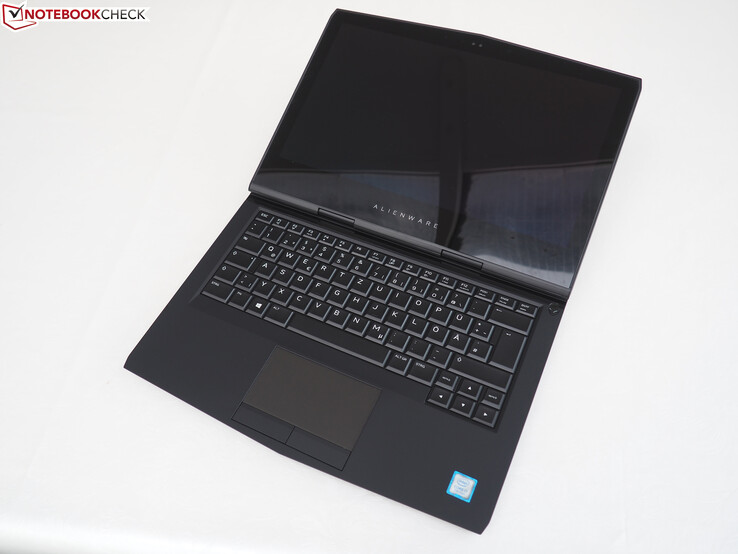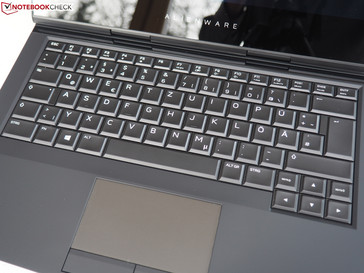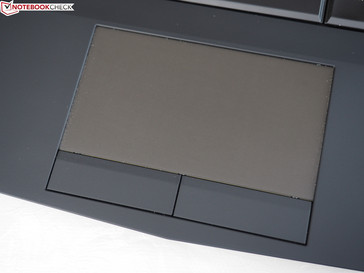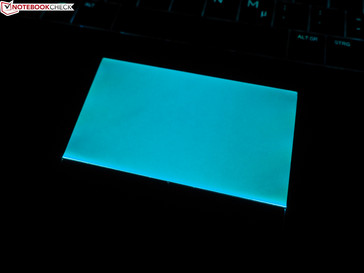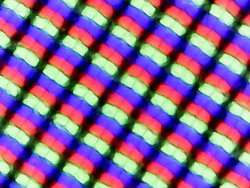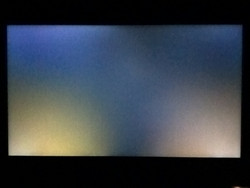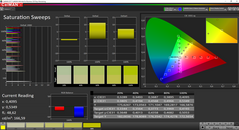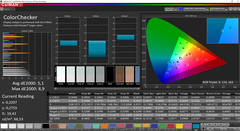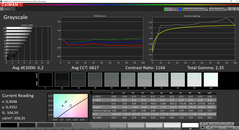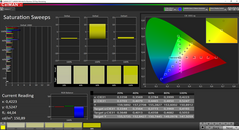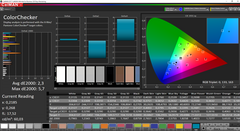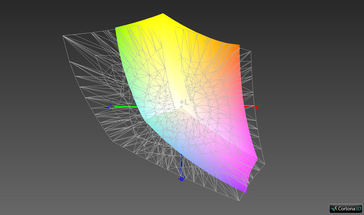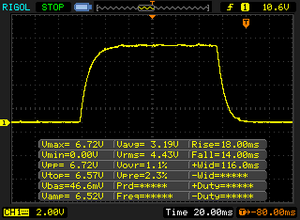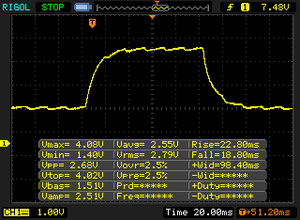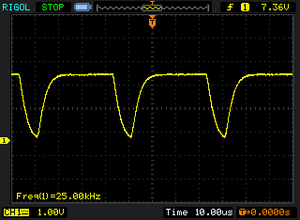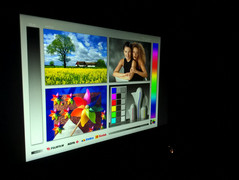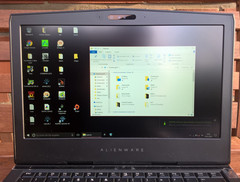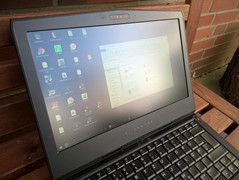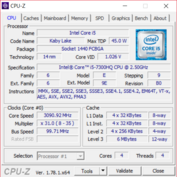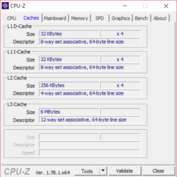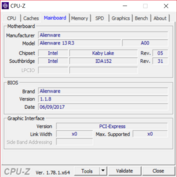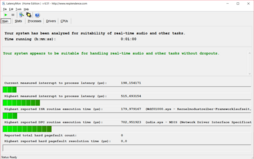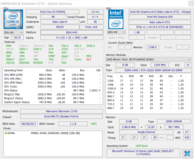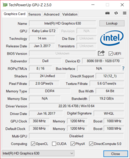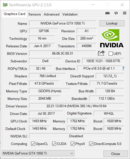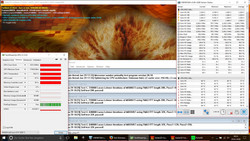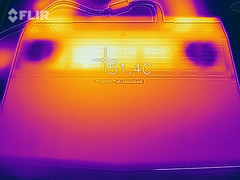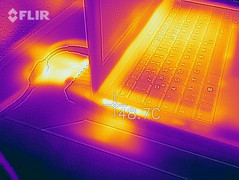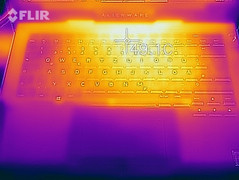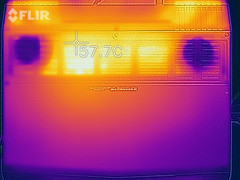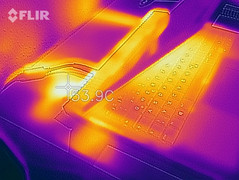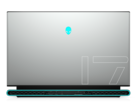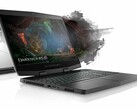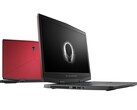Alienware 13 R3 (FHD, i5, GTX 1050 Ti) Laptop Review

We reviewed the Alienware 13 R3 in February of 2017. With a GeForce GTX 1060 and Intel’s Core i7-7700HQ, the previous review device offered the best possible hardware configuration to date. For that kind of performance, gamers would have to pay over 2000 Euros (~$2475), however, what they got in return was one of the best gaming laptops at the time.
For our update, we were provided a somewhat lower-priced Alienware 13 R3 model with Nvidia’s GeForce GTX 1050 Ti as the GPU and Intel’s Core i5-7300HQ as the CPU. 8 GB of RAM and a 256 GB SSD round off the package. At the time of this review, the hardware configuration of our current review device can be ordered for 1549 Euros (~$1945) from Dell’s online store.
The Alienware 13 R3 does not have a lot in the way of competition. Aorus is the only other manufacturer that has a 13-inch gaming laptop (X3 Plus v7) on offer. The other possible competitors of our review device include: The somewhat larger 15-inch Legion Y520-15IKBN from Lenovo, the Aspire V17 Nitro from Acer, as well as the Razer Blade 2017. Both devices come with the same CPU/GPU configuration as our review device. Therefore, the main focus of this review lies in the comparison between the Alienware 13 R3 with a GeForce GTX 1050 Ti and the Alienware 13 R3 with a GeForce GTX 1060.
Case
In terms of the appearance, Alienware has kept everything the same as in the 2017 model. However, our current review device does not come with a touch-enabled OLED display and instead relies on a non-reflective IPS screen. For other information about the case, we recommend you take a look at our previous review of the Alienware 13 R3.
Gaming notebooks often weigh a lot. And so does the Alienware 13 R3. At 2.5 kilograms (5.5 lbs), it weighs as much as some 15-inch devices. Due to the small dimensions of its case, our review device seems very compact. However, it should be noted that the case is relatively thick (because of the cooling solution).
Connectivity
The Alienware 13 R3 offers almost all the ports that one can desire. Most notably, the positioning of the ports at the back of the device results in a lot of free space to the right and the left of the notebook. A special feature is the proprietary port for Alienware’s Graphics Amplifier. It allows an additional box to be connected to the device for an external graphics card. However, the device does not feature an SD card reader.
Communication
The Wi-Fi transfer rates are superb. The Alienware 13 R3 can give any competitor with any kind of Wi-Fi module a run for its money. However, a comparison to our review device from February 2017 shows that the Killer Wireless-n/a/ac 1435 adapter is somewhat faster than the Killer Wireless-n/a/ac 1535 adapter in our current review device. Therefore, the 20-Euro (~$25) premium for the 1535 model is not worth it.
Accessories
The box contains a Quick Start Guide, as well as a heavy 180-watt AC adapter. With the dimensions of 15 x 7.5 x 3 cm (5.9 x 2.9 x 1.2 in), the power supply is not particularly small.
Maintenance
The maintenance options of the Alienware 13 R3 are very limited. You can find a short description of the possibilities in our previous review of the Alienware 13 R3.
Warranty
Dell provides the Alienware 13 R3 with only a base 1-year limited hardware warranty. This warranty includes one year of premium support with onsite service. For a premium, the duration of the warranty can be increased to 2 or 4 years.
Please see our Guarantees, Return Policies and Warranties FAQ for country-specific information.
Input Devices
The keyboard of the Alienware 13 R3 has a great layout. The actuation point of the keys is relatively weak, but clear. A touchpad with dedicated mouse buttons serves as a mouse replacement. The surface of the touchpad is very smooth and registers inputs accurately. For a comprehensive description of the input devices, we recommend you take a look at our review of the Alienware 13 R3 from February 2017.
Display
Our review device is equipped with a matte IPS panel with a resolution of 1920x1080. With this screen, the Alienware 13 R3 is equipped with a standard display for gaming notebooks. Alternatively, you can get the Alienware 13 R3 with a TN panel (1366x768) or an OLED display (2560X1440), which was in our review device from February 2017. The OLED display is touch-enabled and has a glossy surface.
Understandably, our current review device falls far short of the values that we measured with the OLED panel; however, its IPS display can keep up quite well with the rest of the competition. The average brightness is good. As can be seen from the “screen bleeding” image, the brightness is distributed unevenly. However, this should not have any serious implications for everyday gaming.
| |||||||||||||||||||||||||
Brightness Distribution: 80 %
Center on Battery: 359 cd/m²
Contrast: 1171:1 (Black: 0.31 cd/m²)
ΔE ColorChecker Calman: 5.1 | ∀{0.5-29.43 Ø4.78}
ΔE Greyscale Calman: 6.2 | ∀{0.09-98 Ø5}
90.7% sRGB (Argyll 1.6.3 3D)
59.2% AdobeRGB 1998 (Argyll 1.6.3 3D)
66.2% AdobeRGB 1998 (Argyll 3D)
90.9% sRGB (Argyll 3D)
66.1% Display P3 (Argyll 3D)
Gamma: 2.35
CCT: 6827 K
| Alienware 13 R3 (i5-7300HQ, GTX 1050 Ti) Chi Mei CMN1371, , 1920x1080, 13.3" | Alienware 13 R3 JJT6C_133KL05 (SDCA029), , 2560x1440, 13.3" | Lenovo Legion Y520-15IKBN 80WK0042GE LG Philips LP156WF6-SPK3, , 1920x1080, 15.6" | Aorus x3 Plus v7 Sharp SHP1401, , 3200x1800, 13.9" | Razer Blade (2017) LP140WF3-SPD1, , 1920x1080, 14" | |
|---|---|---|---|---|---|
| Display | -39% | 3% | |||
| Display P3 Coverage (%) | 66.1 | 39.01 -41% | 66.1 0% | ||
| sRGB Coverage (%) | 90.9 | 58.4 -36% | 96.5 6% | ||
| AdobeRGB 1998 Coverage (%) | 66.2 | 40.34 -39% | 67.5 2% | ||
| Response Times | 91% | 8% | 17% | 31% | |
| Response Time Grey 50% / Grey 80% * (ms) | 41.6 ? | 39 ? 6% | 38 ? 9% | 25.2 ? 39% | |
| Response Time Black / White * (ms) | 32 ? | 2.8 ? 91% | 29 ? 9% | 24.4 ? 24% | 24.8 ? 22% |
| PWM Frequency (Hz) | 25000 ? | 240 ? | 21000 ? | 201.6 ? | 21370 |
| Screen | 27% | -19% | 18% | 0% | |
| Brightness middle (cd/m²) | 363 | 313 -14% | 283 -22% | 348 -4% | 272 -25% |
| Brightness (cd/m²) | 322 | 310 -4% | 281 -13% | 359 11% | 277 -14% |
| Brightness Distribution (%) | 80 | 87 9% | 91 14% | 73 -9% | 84 5% |
| Black Level * (cd/m²) | 0.31 | 0.39 -26% | 0.29 6% | 0.26 16% | |
| Contrast (:1) | 1171 | 726 -38% | 1200 2% | 1046 -11% | |
| Colorchecker dE 2000 * | 5.1 | 2.54 50% | 6.1 -20% | 2.4 53% | 4.59 10% |
| Colorchecker dE 2000 max. * | 8.9 | 3.94 56% | 11.08 -24% | 5.1 43% | 8.49 5% |
| Greyscale dE 2000 * | 6.2 | 1.43 77% | 5.69 8% | 2.3 63% | 4.28 31% |
| Gamma | 2.35 94% | 2.3 96% | 2.44 90% | 2.21 100% | 2.23 99% |
| CCT | 6827 95% | 6337 103% | 6702 97% | 6206 105% | 6848 95% |
| Color Space (Percent of AdobeRGB 1998) (%) | 59.2 | 78 32% | 37 -37% | 62 5% | 55 -7% |
| Color Space (Percent of sRGB) (%) | 90.7 | 97 7% | 58 -36% | 96 6% | 83 -8% |
| Total Average (Program / Settings) | 59% /
34% | -17% /
-20% | 13% /
14% | 16% /
5% |
* ... smaller is better
The Alienware 13 R3 with an OLED display evinces significantly faster response times and better color accuracy than our review device. Some of the values we measured were so good that our measuring devices hit their limits. When compared to the competition, the IPS panel delivers mediocre, but still decent results. The screen covers 90 percent of the sRGB color space and 59.2 percent of the Adobe RGB color space. The black value and the contrast ratio are also okay, which is reflected in the saturated colors and deep blacks.
Display Response Times
| ↔ Response Time Black to White | ||
|---|---|---|
| 32 ms ... rise ↗ and fall ↘ combined | ↗ 18 ms rise | |
| ↘ 14 ms fall | ||
| The screen shows slow response rates in our tests and will be unsatisfactory for gamers. In comparison, all tested devices range from 0.1 (minimum) to 240 (maximum) ms. » 85 % of all devices are better. This means that the measured response time is worse than the average of all tested devices (20.2 ms). | ||
| ↔ Response Time 50% Grey to 80% Grey | ||
| 41.6 ms ... rise ↗ and fall ↘ combined | ↗ 22.8 ms rise | |
| ↘ 18.8 ms fall | ||
| The screen shows slow response rates in our tests and will be unsatisfactory for gamers. In comparison, all tested devices range from 0.165 (minimum) to 636 (maximum) ms. » 66 % of all devices are better. This means that the measured response time is worse than the average of all tested devices (31.6 ms). | ||
Screen Flickering / PWM (Pulse-Width Modulation)
| Screen flickering / PWM detected | 25000 Hz | ≤ 20 % brightness setting | |
The display backlight flickers at 25000 Hz (worst case, e.g., utilizing PWM) Flickering detected at a brightness setting of 20 % and below. There should be no flickering or PWM above this brightness setting. The frequency of 25000 Hz is quite high, so most users sensitive to PWM should not notice any flickering. In comparison: 53 % of all tested devices do not use PWM to dim the display. If PWM was detected, an average of 8108 (minimum: 5 - maximum: 343500) Hz was measured. | |||
A big flaw of the Alienware 13 R3 with an OLED display is the glossy surface, which exhibits unattractive reflections, even in closed rooms. The matte IPS panel of our current review device has very good viewing angles and a brightness, which is high enough for outdoor use in shaded places. A further advantage of the IPS panel is a very high PWM frequency (25000 Hz), which should not lead to eye strain among susceptible individuals, even after extended periods of use. By contrast, the OLED display flickers very strongly with a frequency of 240 Hz.
Performance
Our review device offers enough performance to run all the latest games smoothly. With this graphics card and CPU, not all of the games can be run smoothly with the highest graphics settings. However, the gaming performance is still very good. For more performance, you can get the Alienware 13 R3 with other GPU variants and an alternative CPU.
Processor
The built-in Intel Core i5-7300HQ is a quad-core processor, which is based on the Kaby Lake architecture. With clock rates between 2.5 and 3.5 GHz per core, the CPU is well-suited for demanding applications. Moreover, dynamically adjusted voltages and clock rates lead to a very high energy efficiency. Alternatively, you can get the Alienware 13 R3 with Intel’s Core i7-7700HQ. When compared to the i5-7300HQ, it offers Hyper-threading, which allows each core to process two threads at the same time, whereas the CPU of our review device can only process one thread per core.
In the Cinebench benchmark, the CPU does worse than the similarly-equipped competing devices. However, the performance of the CPU can be maintained continuously over a prolonged period of time. When running on battery power, the clock rate of the CPU is reduced to 3 GHz, which leads to a 40-point drop in the Cinebench R15 benchmark. The Alienware 13 R3 with the Core i7-7700HQ exhibited similar behavior; there, the performance of the system was mainly influenced by the GPU load. The lower result can also be explained by the lack of Hyper-threading.
You can find out what kind of performance Intel’s Core i5-7300HQ CPU achieves in other systems on our “CPU Benchmarks” page.
System Performance
The system performance of the Alienware 13 R3 is remarkably good. In the PCMark 8 benchmark, our review device performs a tiny bit worse than the better-equipped model from February 2017. It is quite probable that the faster SSD from Samsung is the reason for this result. The gap between the Alienware 13 R3 and other competing devices is also quite small. In day-to-day use, any differences in performance should not be noticeable.
| PCMark 8 Home Score Accelerated v2 | 3664 points | |
| PCMark 8 Work Score Accelerated v2 | 4721 points | |
Help | ||
Storage Devices
Dell has equipped the Alienware 13 R3 with a Samsung PM961 SSD with 256 GB of storage space. This SSD manages to outperform the top-end model of the Alienware 13 R3. Although, the Alienware 13 R3 from February 2017 also had a 256 GB SSD, it was an NVMe SSD from Toshiba that was used in that laptop. Apparently, buyers have no way of telling which type of SSD is used in a given laptop in Dell’s online store. You are only given the choice to select the capacity. Therefore, we cannot tell you which SSD you will get at the end of the day if you order the laptop from Dell’s online store.
You can find out how well the built-in SSD stacks up against the competition on our "HDD/SSD Benchmarks" page.
| Alienware 13 R3 (i5-7300HQ, GTX 1050 Ti) Samsung PM961 MZVLW256HEHP | Alienware 13 R3 Toshiba NVMe THNSN5256GPUK | Lenovo Legion Y520-15IKBN 80WK0042GE Samsung PM961 NVMe MZVLW128HEGR | Aorus x3 Plus v7 Toshiba NVMe THNSN5512GPU7 | Razer Blade (2017) Samsung PM951 NVMe MZVLV256 | |
|---|---|---|---|---|---|
| CrystalDiskMark 3.0 | -21% | -30% | 8% | -35% | |
| Read Seq (MB/s) | 2018 | 1373 -32% | 2127 5% | 1498 -26% | 1122 -44% |
| Write Seq (MB/s) | 1210 | 789 -35% | 796 -34% | 1324 9% | 311 -74% |
| Read 512 (MB/s) | 1089 | 1070 -2% | 455.6 -58% | 966 -11% | 682 -37% |
| Write 512 (MB/s) | 850 | 405.6 -52% | 196.7 -77% | 1221 44% | 310 -64% |
| Read 4k (MB/s) | 58.7 | 37.65 -36% | 46.07 -22% | 44.8 -24% | 34.8 -41% |
| Write 4k (MB/s) | 146.1 | 140.2 -4% | 154.8 6% | 156 7% | 134.3 -8% |
| Read 4k QD32 (MB/s) | 492 | 593 21% | 480.9 -2% | 700 42% | 565 15% |
| Write 4k QD32 (MB/s) | 410.2 | 311.2 -24% | 170.6 -58% | 517 26% | 308 -25% |
Graphics Card
Nvidia’s GeForce GTX 1050 Ti is a mid-range GPU, which can run demanding 3D applications with an appropriate cooling solution. It comes with a maximum of 4 GB of VRAM and a 112 GB/s memory bandwidth. Our review device has the 2 GB variant of the GTX 1050 Ti, which can be upgraded to 4 GB for a premium of 80 Euros ($98). If you pay an additional 180 Euros ($222), you will get the Alienware 13 R3 with a GeForce GTX 1060 with 6 GB of video memory.
The 3D benchmark results of our review device look very good and are comparable to those of the competing devices. When the device runs on battery power, games can still be run smoothly. We did not observe any performance drops even after the device ran on battery power for an extended period of time. You can learn what kind of results Nvidia’s GeForce GTX 1050 Ti achieves in other notebooks on our "GPU Benchmarks" page.
| 3DMark 11 - 1280x720 Performance GPU | |
| Alienware 13 R3 | |
| Razer Blade (2017) | |
| Alienware 13 R3 (i5-7300HQ, GTX 1050 Ti) | |
| Lenovo Legion Y520-15IKBN 80WK0042GE | |
| 3DMark | |
| 1280x720 Cloud Gate Standard Graphics | |
| Alienware 13 R3 | |
| Lenovo Legion Y520-15IKBN 80WK0042GE | |
| Alienware 13 R3 (i5-7300HQ, GTX 1050 Ti) | |
| Aorus x3 Plus v7 | |
| 1920x1080 Fire Strike Graphics | |
| Aorus x3 Plus v7 | |
| Alienware 13 R3 | |
| Razer Blade (2017) | |
| Alienware 13 R3 (i5-7300HQ, GTX 1050 Ti) | |
| Lenovo Legion Y520-15IKBN 80WK0042GE | |
| 3DMark 11 Performance | 8864 points | |
| 3DMark Cloud Gate Standard Score | 15979 points | |
| 3DMark Fire Strike Score | 6590 points | |
Help | ||
Gaming Performance
The Alienware 13 R3 is fit for gaming in any hardware configuration. Most games can be run smoothly, even with high graphical settings. There are no abnormalities to report during gaming. Naturally, the top-end model of the Alienware 13 R3 offers some more performance, but if you want to just play all the latest titles with decent frame rates, then our review device should suffice. The differences to the similarly-equipped competing devices are minimal, where the Alienware 13 R3 manages to gain an edge on the Aorus X3 Plus v7.
Because our review device has only 2 GB of VRAM, it cannot achieve playable frame rates in many games on high graphics settings. Here, buyers are advised to get an Alienware 13 R3 model with the 4 GB version of the GTX 1050 Ti, or the model with the GTX 1060. This is why the notebook is not suitable for future games.
We run "The Witcher 3" for one hour with the ultra settings to see if the performance of the laptop falls during long gaming sessions. However, this is not the case. Except for the normal fluctuations, which are caused by the day/night cycle, there are no problems to report. You can learn which games can be run smoothly with Nvidia’s GeForce GTX 1050 Ti on our "Gaming Benchmarks" page.
| BioShock Infinite | |
| 1920x1080 Ultra Preset, DX11 (DDOF) | |
| Aorus x3 Plus v7 | |
| Lenovo Legion Y520-15IKBN 80WK0042GE | |
| Alienware 13 R3 (i5-7300HQ, GTX 1050 Ti) | |
| 1366x768 High Preset | |
| Alienware 13 R3 (i5-7300HQ, GTX 1050 Ti) | |
| Lenovo Legion Y520-15IKBN 80WK0042GE | |
| 1366x768 Medium Preset | |
| Lenovo Legion Y520-15IKBN 80WK0042GE | |
| Alienware 13 R3 (i5-7300HQ, GTX 1050 Ti) | |
| 1280x720 Very Low Preset | |
| Alienware 13 R3 (i5-7300HQ, GTX 1050 Ti) | |
| Lenovo Legion Y520-15IKBN 80WK0042GE | |
| Thief | |
| 1920x1080 Very High Preset AA:FXAA & High SS AF:8x | |
| Alienware 13 R3 (i5-7300HQ, GTX 1050 Ti) | |
| Aorus x3 Plus v7 | |
| 1366x768 High Preset AA:FXAA & Low SS AF:4x | |
| Alienware 13 R3 (i5-7300HQ, GTX 1050 Ti) | |
| 1366x768 Normal Preset AA:FX | |
| Alienware 13 R3 (i5-7300HQ, GTX 1050 Ti) | |
| 1024x768 Very Low Preset | |
| Alienware 13 R3 (i5-7300HQ, GTX 1050 Ti) | |
| Rise of the Tomb Raider | |
| 1920x1080 Very High Preset AA:FX AF:16x | |
| Aorus x3 Plus v7 | |
| Razer Blade (2017) | |
| Alienware 13 R3 (i5-7300HQ, GTX 1050 Ti) | |
| 1920x1080 High Preset AA:FX AF:4x | |
| Razer Blade (2017) | |
| Alienware 13 R3 (i5-7300HQ, GTX 1050 Ti) | |
| 1366x768 Medium Preset AF:2x | |
| Alienware 13 R3 (i5-7300HQ, GTX 1050 Ti) | |
| 1024x768 Lowest Preset | |
| Razer Blade (2017) | |
| Alienware 13 R3 (i5-7300HQ, GTX 1050 Ti) | |
| low | med. | high | ultra | |
|---|---|---|---|---|
| BioShock Infinite (2013) | 229.2 | 187.4 | 166.4 | 69.8 |
| Thief (2014) | 66 | 66.4 | 65.3 | 50.3 |
| Dragon Age: Inquisition (2014) | 88.6 | 82 | 54 | 38.5 |
| The Witcher 3 (2015) | 119.5 | 90 | 40.5 | 28.3 |
| Rise of the Tomb Raider (2016) | 83.8 | 70.6 | 46.5 | 27.8 |
Emissions
System Noise
During normal operation, the Alienware 13 R3 is practically silent. Under load, it takes about 70 seconds for the fan to become audible in the 3DMark benchmark. While playing games, like “The Witcher 3
”, for example, it takes 37 seconds for the fan to start spinning. The resulting noise is quite audible, but remains steady. For such a compact gaming laptop, the noise level is more than acceptable. You can find more information about the noise development in the review of the Alienware 13 R3 from February 2017.
Noise level
| Idle |
| 29.7 / 29.7 / 29.7 dB(A) |
| Load |
| 32.7 / 50 dB(A) |
 | ||
30 dB silent 40 dB(A) audible 50 dB(A) loud |
||
min: | ||
Temperature
During office work, the Alienware 13 R3 does not get hot at all, and the surface temperatures do not exceed the 25 °C (77 °F) mark. Under load, the temperatures on the underside of the laptop reach up to 55 °C (131 °F). However, the wrist rest area remains comfortably cool and the notebook can still be used on your lap. During gaming, the temperatures are actually somewhat lower than in our stress test.
During our stress test, the Alienware 13 R3 gets truly challenged. It takes less than 10 minutes for the core temperatures to reach the 80 °C (176 °F) mark. Afterwards, the fans start to spin faster and faster, preventing the temperatures from going above 80 °C (176 °F) for the remainder of the one-hour stress test. This is why the clock speeds fell briefly below the base clock rate of the Core i5-7300HQ, however they climbed back up after a while. After that, a clock rate of about 3 GHz was maintained for the remainder of the one-hour stress test. Even during intensive gaming sessions, the utilization levels seen in the stress test cannot be replicated. Therefore, there should not arise any limitations, because of throttling on account of very high temperatures.
(-) The maximum temperature on the upper side is 46.1 °C / 115 F, compared to the average of 40.4 °C / 105 F, ranging from 21.2 to 68.8 °C for the class Gaming.
(-) The bottom heats up to a maximum of 55 °C / 131 F, compared to the average of 43.3 °C / 110 F
(+) In idle usage, the average temperature for the upper side is 23.6 °C / 74 F, compared to the device average of 33.9 °C / 93 F.
(±) Playing The Witcher 3, the average temperature for the upper side is 36.2 °C / 97 F, compared to the device average of 33.9 °C / 93 F.
(+) The palmrests and touchpad are reaching skin temperature as a maximum (32.7 °C / 90.9 F) and are therefore not hot.
(-) The average temperature of the palmrest area of similar devices was 28.9 °C / 84 F (-3.8 °C / -6.9 F).
Energy Management
Energy Consumption
The energy consumption of our review device is on the normal level for gaming notebooks. With 6 to 12 watts when idle, the Alienware 13 R3 with the GeForce GTX 1050 Ti is somewhat more energy-efficient than the model with the GeForce GTX 1060. Our current review model also consumes less power under load than the review device from February 2017. When compared to other gaming notebooks with the GeForce GTX 1050 Ti, the laptop draws significantly more power.
With the power draw peaking at 146.6 watts, the included 180-watt AC adapter should be able to reliably supply the notebook with power without any problems.
| Off / Standby | |
| Idle | |
| Load |
|
Key:
min: | |
| Alienware 13 R3 (i5-7300HQ, GTX 1050 Ti) i5-7300HQ, GeForce GTX 1050 Ti Mobile, Samsung PM961 MZVLW256HEHP, IPS, 1920x1080, 13.3" | Alienware 13 R3 i7-7700HQ, GeForce GTX 1060 Mobile, Toshiba NVMe THNSN5256GPUK, OLED, 2560x1440, 13.3" | Lenovo Legion Y520-15IKBN 80WK0042GE i5-7300HQ, GeForce GTX 1050 Ti Mobile, Samsung PM961 NVMe MZVLW128HEGR, IPS, 1920x1080, 15.6" | Aorus x3 Plus v7 i7-7820HK, GeForce GTX 1060 Mobile, Toshiba NVMe THNSN5512GPU7, IGZO TFT, 3200x1800, 13.9" | Razer Blade (2017) i7-7700HQ, GeForce GTX 1060 Mobile, Samsung PM951 NVMe MZVLV256, IPS, 1920x1080, 14" | |
|---|---|---|---|---|---|
| Power Consumption | -21% | 16% | -57% | -8% | |
| Idle Minimum * (Watt) | 6.6 | 7 -6% | 5.2 21% | 15.1 -129% | 7.5 -14% |
| Idle Average * (Watt) | 9.5 | 12 -26% | 8.3 13% | 15.8 -66% | 12.1 -27% |
| Idle Maximum * (Watt) | 12.7 | 18 -42% | 10.1 20% | 16.7 -31% | 14.3 -13% |
| Load Average * (Watt) | 64 | 76 -19% | 62.7 2% | 110.9 -73% | 73.5 -15% |
| Witcher 3 ultra * (Watt) | 105 | 94 10% | 135 -29% | 108 -3% | |
| Load Maximum * (Watt) | 146.6 | 161 -10% | 100 32% | 170.4 -16% | 110.2 25% |
* ... smaller is better
Battery Life
Just like the previously-reviewed model of the Alienware 13 R3, our current review device does very well in terms of battery life, taking the lead among the competing devices. In our practically-oriented Wi-Fi test, the gaming notebook can surf the web for more than 7 hours before shutting down. The brightness during our stress test is set to 150 cd/m² or 40%. However, prolonged gaming sessions on battery power are out of the question. Under full load, the battery can only last for about 90 minutes.
| Alienware 13 R3 (i5-7300HQ, GTX 1050 Ti) i5-7300HQ, GeForce GTX 1050 Ti Mobile, 76 Wh | Alienware 13 R3 i7-7700HQ, GeForce GTX 1060 Mobile, 76 Wh | Lenovo Legion Y520-15IKBN 80WK0042GE i5-7300HQ, GeForce GTX 1050 Ti Mobile, 45 Wh | Aorus x3 Plus v7 i7-7820HK, GeForce GTX 1060 Mobile, 74 Wh | Razer Blade (2017) i7-7700HQ, GeForce GTX 1060 Mobile, 70 Wh | |
|---|---|---|---|---|---|
| Battery runtime | -23% | -20% | -22% | 18% | |
| Reader / Idle (h) | 12.8 | 8.7 -32% | 10.6 -17% | 8 -37% | |
| WiFi v1.3 (h) | 7.7 | 5.3 -31% | 5.2 -32% | 4.9 -36% | 9.1 18% |
| Load (h) | 1.6 | 1.5 -6% | 1.4 -12% | 1.7 6% | |
| H.264 (h) | 6 | 4.5 |
Verdict
Pros
Cons
Our impression of the Alienware 13 R3 is strengthened by the current review device. In extreme cases, the notebook can get very hot. However, this does not have much of an impact on gaming performance. The case is extremely well-built and offers the typical Alienware design with many illuminated elements. The device’s hardware offers enough performance to run all the latest titles. The high value of the components is reflected in the weight of the device.
Even with the low-priced GeForce GTX 1050 Ti, the Alienware 13 R3 is still a very high-value gaming notebook, which can run all the latest games smoothly. Unfortunately, the maintenance options leave a lot to be desired.
The built-in IPS panel offers a great color reproduction and has an advantage over the optional OLED display, in that it does not come with a glossy screen surface and, therefore, can also be used in brightly-lit environments. Above all, buyers should be aware that the maintenance options are seriously limited and that the fan can only be cleaned with a lot of effort. For those who do not care about this sort of thing, the Alienware 13 R3 with the GeForce GTX 1050 Ti and the Intel Core i5-7300HQ represents a great, compact gaming device fit for both indoor and outdoor use.
Alienware 13 R3 (i5-7300HQ, GTX 1050 Ti)
- 02/04/2018 v6 (old)
Mike Wobker




